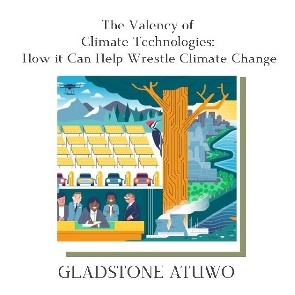Climate change is one of the most pressing issues of our time. The effects of global warming are becoming increasingly apparent, and the need for action is greater than ever. Fortunately, technology is proving to be a powerful tool in the fight against climate change. From renewable energy to smart cities, technology is helping us reduce our carbon footprint and mitigate the effects of climate change.
In this post, we'll explore the ways in which technology is being used to combat climate change and how it can help us create a more sustainable future. We'll look at new and emerging technologies, as well as established ones, and how they're helping to reduce emissions, improve energy efficiency, and promote sustainability. So, if you're interested in learning about the power of tech and how it can help solve one of the world's biggest problems, keep reading.
Introduction to the role of technology in addressing climate change
Climate change is a global problem that requires global solutions. As the world faces the impacts of rising temperatures, changing weather patterns, and extreme weather events, technology has emerged as a key tool in combating climate change. From renewable energy sources to smart agriculture and sustainable transportation, technological innovations are enabling us to reduce our carbon footprint and transition to a low-carbon economy.
Technology is helping us to better understand the impacts of climate change and to monitor and track emissions levels. The use of data analytics, machine learning, and artificial intelligence is allowing us to identify trends and patterns in weather patterns, predict future climate impacts, and develop targeted mitigation strategies.
Moreover, advancements in renewable energy technologies, such as solar, wind, and hydropower, are providing cleaner, more sustainable alternatives to traditional fossil-fueled energy sources. These technologies are not only reducing greenhouse gas emissions but also creating new jobs and stimulating economic growth.
In this blog post, we will explore the ways in which technology is being used to combat climate change and promote sustainability. From innovative clean energy solutions to sustainable transportation and agriculture practices, we will examine the role of technology in addressing this critical global challenge.
The impact of climate change on the environment and human well-being
Climate change can have a significant impact on both the environment and human well-being. Rising temperatures can lead to more frequent and severe heat waves, which can cause heat exhaustion and heatstroke. Changes in precipitation patterns can also lead to more frequent and severe floods and droughts, which can damage crops and impact food security.
In addition, climate change can lead to the spread of diseases, as warmer temperatures create a more hospitable environment for disease-carrying insects and animals.
The impact of climate change on the environment can be equally devastating. Rising sea levels can lead to the loss of coastal habitats and the displacement of communities living in low-lying areas. Changes in temperature and precipitation patterns can also lead to the loss of biodiversity and the extinction of species that are unable to adapt to changing conditions. The melting of polar ice caps and glaciers can also contribute to rising sea levels, which can have a cascading impact on the world's oceans and the marine life that call them home.
It is clear that the impact of climate change is far-reaching and can have serious consequences for both the environment and human well-being. However, by leveraging the power of technology, we can take steps to mitigate these impacts and work towards a more sustainable future.
Innovative technologies that can help reduce carbon emissions
Innovative technologies have a crucial role to play in reducing carbon emissions and combating climate change. With the rapid advancements in technology, there are several solutions available that can help us achieve the ambitious goal of reducing carbon emissions to a great extent.
One of the most significant technological advancements that can help reduce carbon emissions is the development of renewable energy sources. Solar, wind, and hydroelectric power are becoming increasingly popular and are already making a significant impact on reducing carbon emissions. Electric vehicles are another example of innovative technology that can help in reducing carbon emissions in the transportation sector.
Another technology that is gaining momentum in the fight against climate change is carbon capture and storage (CCS). CCS technologies can capture carbon dioxide emissions from industrial processes and store them underground. This process can greatly reduce carbon emissions from the industrial sector.
In addition, smart buildings and cities are also becoming a popular concept. These buildings and cities use innovative technology to reduce energy consumption and carbon emissions. For instance, smart buildings are designed in a way that they use natural light, optimize HVAC systems, and use energy-efficient appliances to reduce energy usage.
In conclusion, innovative technologies have the potential to reduce carbon emissions and help combat climate change. With the right investments and policy changes, we can accelerate the use of these technologies to create a sustainable future for generations to come.
Renewable energy sources as a solution to combat climate change
Renewable energy sources have become an increasingly popular solution to combat climate change. Unlike fossil fuels, renewable energy sources such as wind, solar, and hydroelectric power do not emit greenhouse gases that contribute to global warming. In addition, renewable energy sources are abundant, widely distributed, and readily available to harness.
While renewable energy sources have been around for many years, recent advancements in technology have made them more efficient, cost-effective, and accessible. For example, the development of new materials and designs has made wind turbines more efficient and able to generate more power with less wind. Similarly, advancements in solar technology have made solar panels more efficient and affordable, making it more accessible to households and businesses alike.
In addition, renewable energy sources can also provide a range of benefits beyond reducing greenhouse gas emissions. For example, hydroelectric power can help with flood control and provide water for irrigation, while wind and solar power can provide economic benefits through job creation and investment opportunities.
Overall, renewable energy sources have the potential to play a key role in combatting climate change, and with continued investment in technology and infrastructure, we can work towards a more sustainable future for generations to come.
Smart grid technology and its potential for energy efficiency and reduction of carbon footprint
Smart grid technology is an advanced energy system that uses digital communications technology, sensors, and automation to manage the flow of energy in a more efficient and sustainable way. This technology has enormous potential for reducing carbon emissions and combating climate change.
Traditional energy systems are often inefficient, with power generated in large, centralized power plants and transmitted over long distances to end-users. This results in significant energy losses, as well as increased greenhouse gas emissions from transportation and energy generation.
Smart grid technology enables a more decentralized energy system, with power generated from renewable sources such as solar panels, wind turbines, and hydroelectric plants. This energy is then stored in advanced batteries and distributed over a network of smart meters and sensors, allowing for more efficient and effective use of energy.
By using smart grid technology, we can reduce energy waste, save money on energy bills, and reduce carbon emissions. In addition, this technology enables the integration of electric vehicles and other clean energy technologies, further reducing our reliance on fossil fuels and helping to combat climate change.
Overall, smart grid technology has enormous potential for transforming the energy industry and helping us to achieve a more sustainable and low-carbon future.
Green buildings technology and its role in reducing energy consumption and creating sustainable living spaces
Green buildings technology is playing a vital role in reducing energy consumption and creating sustainable living spaces. With the increasing awareness of climate change and its impact on the environment, more and more people are seeking ways to reduce their carbon footprint. Green buildings technology is an excellent solution for this purpose.
Green buildings are designed to maximize energy efficiency while minimizing the impact on the environment. They utilize various technologies such as solar panels, smart thermostats, and energy-efficient lighting. These technologies help to reduce energy consumption, thus decreasing the carbon footprint of the building.
Moreover, green buildings technology also focuses on improving indoor air quality, reducing water consumption, and minimizing waste. This ensures a healthy environment for the occupants while reducing the environmental impact of the building.
The use of green buildings technology has many benefits, not only for the environment but also for the occupants. It can reduce energy bills, improve the comfort and well-being of the occupants, and increase the value of the property.
In conclusion, green buildings technology is a powerful tool that can help combat climate change. By reducing energy consumption and creating sustainable living spaces, we can reduce our carbon footprint and contribute to creating a healthier environment for future generations.
Advancements in transportation technology to reduce the reliance on fossil fuels
Transportation is one of the largest contributors to greenhouse gas emissions. The good news is that advancements in transportation technology are providing innovative solutions to reduce our reliance on fossil fuels. There are several exciting developments in this field that are worth noting.
Electric vehicles are rapidly gaining popularity as a cleaner alternative to gasoline-powered cars. With improvements in battery technology, electric cars can travel further distances on a single charge, making them a practical choice for daily commutes and longer trips.
Another promising development is the use of biofuels made from renewable resources such as corn, sugarcane, and soybeans. Biofuels are a cleaner alternative to traditional gasoline and diesel fuels, and they emit fewer greenhouse gases.
In addition, advancements in public transportation have made it easier and more convenient for people to use public transit as an alternative to driving. High-speed rail, bus rapid transit, and other forms of mass transit are becoming faster and more efficient, reducing the carbon footprint of transportation.
Finally, the use of drones for delivery services could significantly reduce the number of vehicles on the road, cutting down on emissions and traffic congestion.
These advancements in transportation technology are just a few examples of how innovation can help combat climate change. By embracing new technologies and reducing our reliance on fossil fuels, we can work towards a more sustainable future.
Precision agriculture and its potential to reduce greenhouse gas emissions
Precision agriculture is a farming technique that uses technology to measure and monitor crop growth, soil health, and weather patterns. It helps farmers make data-driven decisions about when and where to plant, fertilize, and harvest crops. This not only maximizes crop yields but also reduces the amount of fertilizers, pesticides, and water needed for farming, which in turn reduces greenhouse gas emissions.
Precision agriculture also helps farmers reduce soil tillage, which is a farming practice that releases large amounts of carbon dioxide into the atmosphere. The use of precision agriculture equipment, such as drones and sensors, helps farmers till only the necessary areas, leaving the rest of the soil undisturbed. This helps the soil sequester carbon, which reduces the amount of carbon dioxide in the atmosphere.
The use of precision agriculture has been shown to increase crop yields by up to 30% while reducing fertilizer use by up to 50%. This shows the potential for technology to not only improve farming practices but also combat climate change by reducing greenhouse gas emissions.
Additionally, precision agriculture helps farmers adapt to climate change by providing real-time data on weather patterns, soil moisture levels, and crop growth rates. This information allows farmers to adjust their farming practices accordingly, reducing the risk of crop failure due to extreme weather events.
In conclusion, precision agriculture is a powerful tool that can help combat climate change by reducing greenhouse gas emissions, improving soil health, and increasing crop yields. Its potential to revolutionize the way we farm should be embraced and supported by governments and agricultural organizations worldwide.
The role of artificial intelligence in climate change mitigation and adaptation
Artificial intelligence (AI) has been making waves in recent years and has been used in various industries such as healthcare, finance, and retail. However, the potential of AI in climate change mitigation and adaptation is still largely untapped.
AI can help in reducing greenhouse gas emissions through improved energy efficiency and smarter resource management. For instance, AI-powered systems can optimize energy consumption in buildings, factories, and transportation systems.
In addition, AI can also help in predicting and managing the impacts of climate change. By analyzing large amounts of data, AI can help identify areas that are most vulnerable to the effects of climate change such as flooding, drought, and wildfires. This information can then be used to develop better adaptation and mitigation strategies.
One example of AI being used for climate change adaptation is the Flood Prediction Model in India. This model uses AI to analyze data from satellite images, weather stations, and river sensors to predict floods up to three days in advance. This information is then used to alert authorities and residents in affected areas, allowing them to take necessary precautions and minimize the damage caused by flooding.
Overall, the potential of AI in combating climate change is immense. By leveraging the power of AI, we can develop more effective climate change strategies, reduce our carbon footprint, and create a more sustainable future.
Conclusion and future outlook on the power of technology to combat climate change
In conclusion, the power of technology in combating climate change cannot be overstated. From renewable energy sources to smart homes, to sustainable transportation, technology has a huge role to play in reducing greenhouse gas emissions and mitigating the effects of climate change.
The future looks promising as technology continues to evolve and become more advanced. We can expect to see more innovative and sustainable solutions being developed to combat climate change.
However, it's important to note that technology alone is not enough. It's essential that individuals, governments, and corporations all work together to make the necessary changes to reduce emissions and protect our planet.
Let us all embrace the power of technology, but also remember that every action we take, no matter how small, can make a positive impact on the environment. By working together, we can create a sustainable future for ourselves and generations to come.
Opinions of Thursday, 18 May 2023
Columnist: Gladstone Atuwo



















